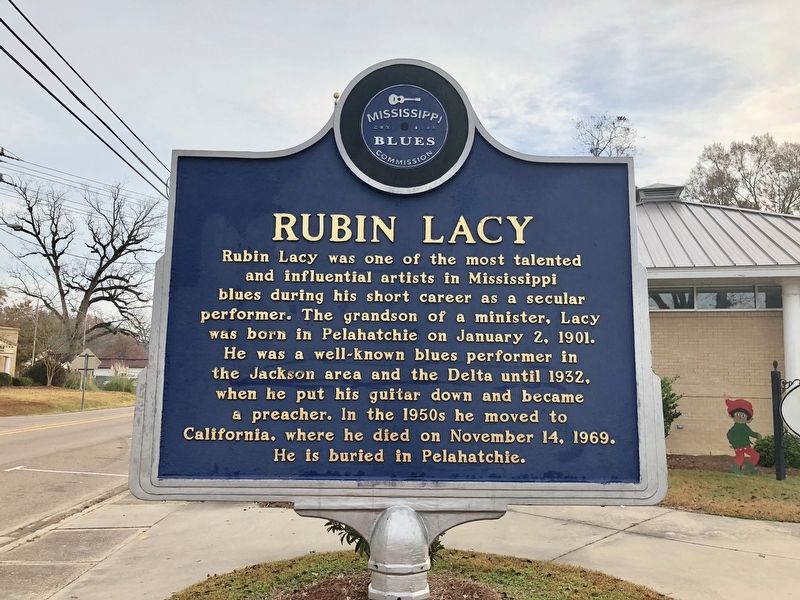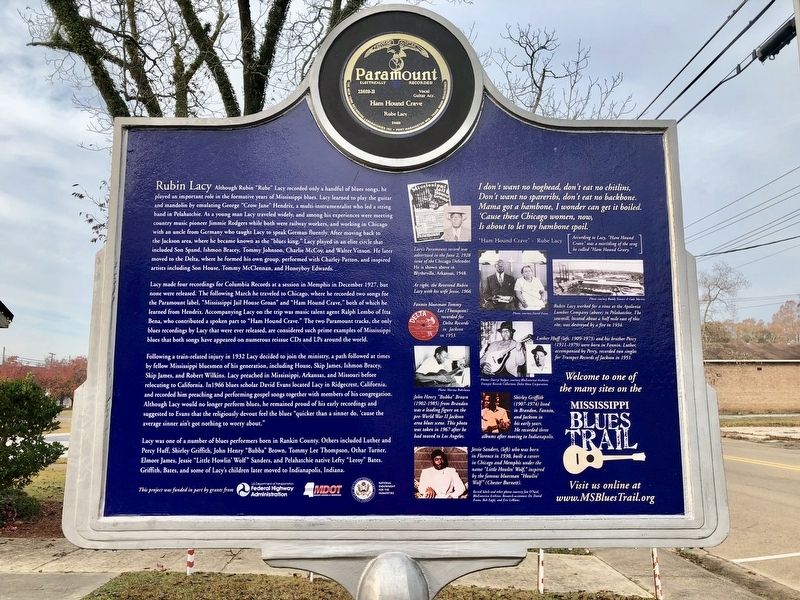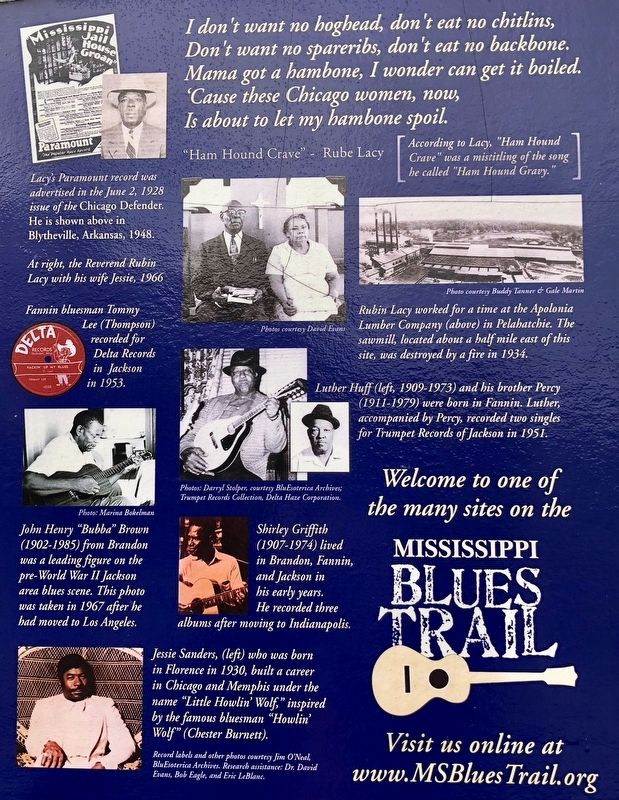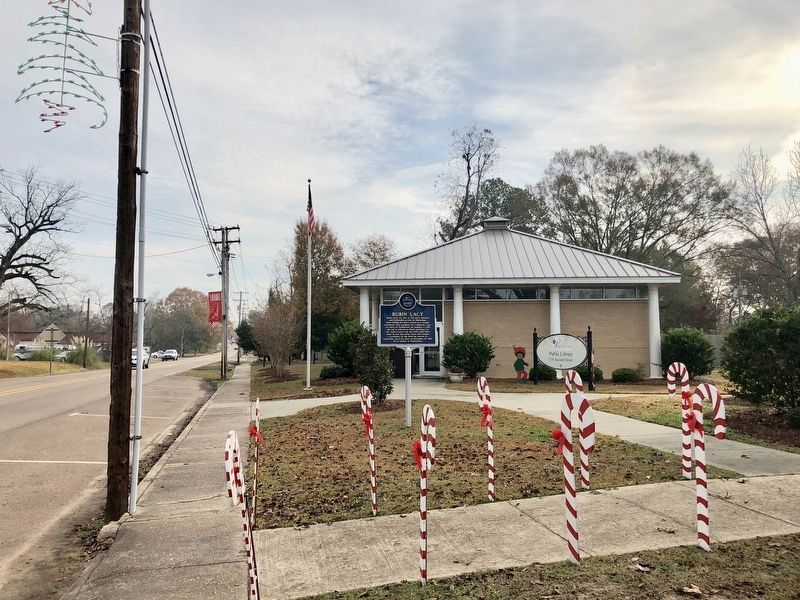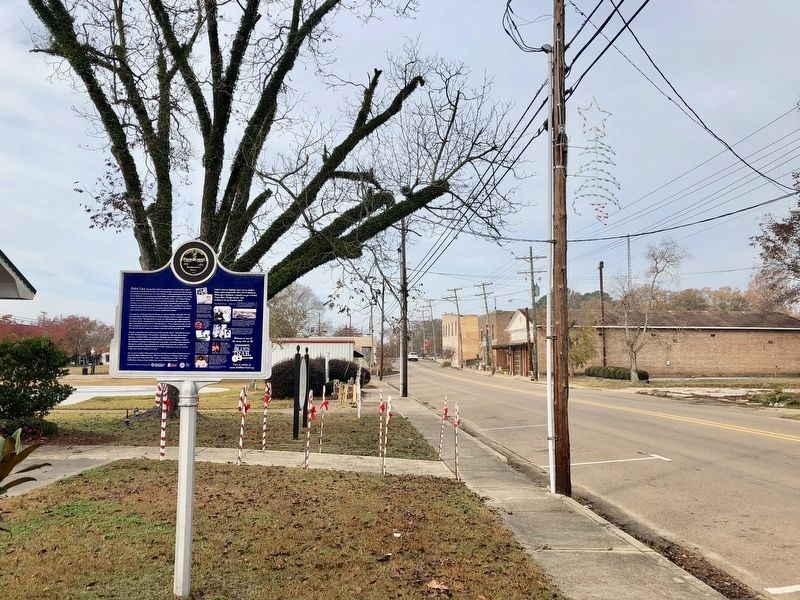Pelahatchie in Rankin County, Mississippi — The American South (East South Central)
Rubin Lacy
Front
Rubin Lacy was one of the most talented and influential artists in Mississippi blues during his short career as a secular performer. The grandson of a minister, Lacy was born in Pelahatchie on January 2, 1901. He was a well-known blues performer in the Jackson area and the Delta until 1932, when he put his guitar down and became a preacher. In the 1950s he moved to California, where he died on November 14, 1969. He is buried in Pelahatchie.
Rear
Rubin Lacy Although Rubin “Rube” Lacy recorded only a handful of blues songs, he played an important role in the formative years of Mississippi blues. Lacy learned to play the guitar and mandolin by emulating George “Crow Jane” Hendrix, a multi-instrumentalist who led a string band in Pelahatchie. As a young man Lacy traveled widely, and among his experiences were meeting country music pioneer Jimmie Rodgers while both were railway workers, and working in Chicago with an uncle from Germany who taught Lacy to speak German fluently. After moving back to the Jackson area, where he became known as the “blues king,” Lacy played in an elite circle that included Son Spand, Ishmon Bracey, Tommy Johnson, Charlie McCoy, and Walter Vinson. He later moved to the Delta, where he formed his own group, performed with Charley Patton, and inspired artists including Son House, Tommy McClennan, and Honeyboy Edwards.
Lacy made four recordings for Columbia Records at a session in Memphis in December 1927, but none were released. The following March he traveled to Chicago, where he recorded two songs for the Paramount label, “Mississippi Jail House Groan” and “Ham Hound Crave,” both of which he learned from Hendrix. Accompanying Lacy on the trip was music talent agent Ralph Lembo of Itta Bena, who contributed a spoken part to “Ham Hound Crave.” The two Paramount tracks, the only blues recordings by Lacy that were ever released, are considered such prime examples of Mississippi blues that both songs have appeared on numerous reissue CDs and LPs around the world.
Following a train-related injury in 1932 Lacy decided to join the ministry, a path followed at times by fellow Mississippi bluesmen of his generation, including House, Skip James, Ishmon Bracey, Skip James, and Robert Wilkins. Lacy preached in Mississippi, Arkansas, and Missouri before relocating to California. In1966 blues scholar David Evans located Lacy in Ridgecrest, California, and recorded him preaching and performing gospel songs together with members of his congregation. Although Lacy would no longer perform blues, he remained proud of his early recordings and suggested to Evans that the religiously devout feel the blues “quicker than a sinner do, ‘cause the average sinner ain’t got nothing to worry about.”
Lacy was one of a number of blues performers born in Rankin County. Others included Luther and Percy Huff, Shirley Griffith, John Henry “Bubba” Brown, Tommy Lee Thompson, Othar Turner, Elmore James, Jessie “Little Howlin’ Wolf” Sanders, and Pelahatchie native Lefty “Leroy” Bates. Griffith, Bates, and some of Lacy’s children later moved to Indianapolis, Indiana.*
Erected 2009 by the Mississippi Blues Commission. (Marker Number 61.)
Topics and series. This historical marker is listed in these topic lists: African Americans • Arts, Letters, Music • Entertainment. In addition, it is included in the Mississippi Blues Trail series list. A significant historical date for this entry is January 2, 1901.
Location. 32° 18.801′ N, 89° 47.847′ W. Marker is in Pelahatchie, Mississippi, in Rankin County. Marker is on Second Street (U.S. 80) east of Goforth Street, on the right when traveling east. Located between the Pelahatchie Museum and the Pelahatchie Library. Touch for map. Marker is at or near this postal address: 716 Second Street, Pelahatchie MS 39145, United States of America. Touch for directions.
Other nearby markers. At least 8 other markers are within 12 miles of this marker, measured as the crow flies. Centenary College (approx. 3.8 miles away); Choctaw Line (approx. 4.4 miles away); Shiloh Methodist Campground (approx. 5.7 miles away); The Ueltschey Tannery (approx. 7.7 miles away); Branch School (approx. 10.1 miles away); Smith County Jamboree (approx. 10.2 miles away); Rankin County Courthouses (approx. 11.4 miles away); Rankin County War Memorial (approx. 11.4 miles away).
Regarding Rubin Lacy. Although Lacy's death certificate gave Pelahatchie as his burial site, his son John L. Lacy reports that he was buried in Bakersfield, California.
Known variations of his name: Reverend (Rev.) Rubin Lacy, Rube Lacey, Rube Lacy and Reubin Lacy.
Also see . . . Wikipedia article on Rubin Lacey. (Submitted on December 4, 2017, by Mark Hilton of Montgomery, Alabama.)
Credits. This page was last revised on December 4, 2017. It was originally submitted on December 4, 2017, by Mark Hilton of Montgomery, Alabama. This page has been viewed 356 times since then and 61 times this year. Photos: 1, 2, 3, 4, 5. submitted on December 4, 2017, by Mark Hilton of Montgomery, Alabama.
